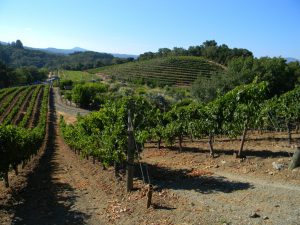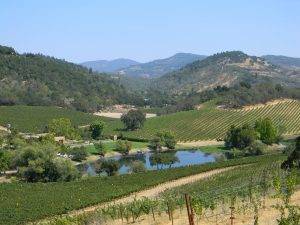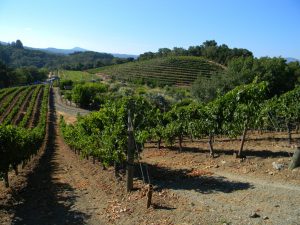Climate exposure shows high risk and few climate refugia for Chilean native vegetation
The many Gondwanic vegetation types found across the extensive latitudes and elevation gradients of South America’s southern cone contribute to Chile’s global biodiversity hotspot ranking. Species loss in global biodiversity hotspots is an ongoing climate change concern and land managers need spatially explicit climate risk maps to adapt conservation strategies to climate change in these areas. We modeled future climate risk for Chile’s terrestrial vegetation using a high-resolution vegetation map and tested the relationship to climate risk for each type’s latitudinal and elevation range. We found that 43.6% of all vegetation has high climate risk in Global Circulation Models (GCMs) under a high emissions scenario (RCP8.5). All forest types in the country, including Southern Beech (Nothofagus sp.), Alerce (Fitzroya cupressoides), Araucaria (Araucaria araucana), and Sclerophyllous, as well as the Valdivian rainforest, Altiplanic Steppes, and Salares, face high levels of climate risk. Tests for trends in risk across elevation and latitude showed that exposure for all types increased with elevation based on the MIROC5 GCM, and decreased with latitude based on the Had2GEM-ES GCM. Our results suggest that vegetation types with smaller latitudinal ranges typically have higher levels of climate risk, but a type’s elevation range is not significantly correlated with risk of exposure. We identified climatically stable areas which could act as vegetation refugia in Patagonia, the central Andes mountains between latitudes 27.5°S and 32.5°S, and some coastal areas. Conservation strategies in Chile should include the protection of climatically stable areas to safeguard current Gondwanic biodiversity and active habitat restoration in climatically exposed areas to facilitate vegetation shifts.
https://doi.org/10.1016/j.scitotenv.2021.147399
Restoration and Conservation of Priority Areas of Caatinga’s Semi-Arid Forest Remnants Can Support Connectivity within an Agricultural Landscape
Land-use and land-cover (LULC) changes are major drivers of biodiversity loss in semi-arid regions, such as the Caatinga biome located in the Northeast of Brazil. We investigated landscape dynamics and fragmentation in an area of the São Francisco Valley in the Brazilian Caatinga biome and measured the effect of these dynamics on ecological, functional and structural connectivity over a 33-year period (1985–2018). We calculated landscape connectivity indices based on graph theory to quantify the effect of further agricultural expansion on ecological connectivity at the landscape scale. We used a multicriteria decision analysis that integrates graph-based connectivity indices at the habitat patch scale, combined with an index of human disturbance to identify patches that, if conserved and restored, preserve the connectivity of the landscape most effectively. In the period studied, agriculture increased at a rate of 2104 ha/year, while native Caatinga vegetation decreased at a rate of 5203 ha/year. Both dense and open Caatinga became more fragmented, with the number of fragments increasing by 85.2% and 28.6%, respectively, whilst the average fragment size decreased by 84.8% and 6.1% for dense and open Caatinga, respectively. If agriculture patches were to expand by a 300 m buffer around each patch, the overall ecological connectivity could be reduced by 6–15%, depending on the species’ (small- to mid-size terrestrial vertebrates) mobility characteristics for which the connectivity indices were calculated. We provided explicit spatial connectivity and fragmentation information for the conservation and restoration of the Caatinga vegetation in the studied area. This information helps with conservation planning in this rapidly changing ecosystem.
https://doi.org/10.3390/land10060550
Training future generations to deliver evidence-based conservation and ecosystem management
To be effective, the next generation of conservation practitioners and managers need to be critical thinkers with a deep understanding of how to make evidence-based decisions and of the value of evidence synthesis.
If, as educators, we do not make these priorities a core part of what we teach, we are failing to prepare our students to make an effective contribution to conservation practice.
To help overcome this problem we have created open access online teaching materials in multiple languages that are stored in Applied Ecology Resources. So far, 117 educators from 23 countries have acknowledged the importance of this and are already teaching or about to teach skills in appraising or using evidence in conservation decision-making. This includes 145 undergraduate, postgraduate or professional development courses.
We call for wider teaching of the tools and skills that facilitate evidence-based conservation and also suggest that providing online teaching materials in multiple languages could be beneficial for improving global understanding of other subject areas.
https://doi.org/10.1002/2688-8319.12032
Challenges for agroecology development for the building of sustainable agri-food systems
Environmental and social crises in agriculture have led to a growing recognition that more ecologically sustainable and socially just food and agricultural systems are needed. This thematic number of the International Journal of Agriculture and Natural Resources gathers the papers submitted to the workshop “Challenges for agroecology development for the building of sustainable agri-food systems,” an OECD Co-operative Research Programme-sponsored conference. The aim of the workshop was to promote the transition from conventional agriculture towards agroecology as a science, practice, and social movement through sharing the experiences of different OECD countries: Australia, Canada, Chile, Colombia, Hungary, Italy, Netherlands, Norway, Spain, Sweden, and the United States. The main topics discussed at the workshop included i) agroecology development in OECD countries: local experiences and international collaboration; ii) agroecology as a social movement and related public policies; iii) agroecology education to promote sustainable agri-food systems; and iv) science, innovation, and technologies in agroecological systems. While not a comprehensive assessment of the state of agroecology in OECD countries, this thematic number integrates diverse perspectives on some main research and policy advances and uncovers some existing gaps in agroecology practice as an approach for transitioning towards ecologically sustainable and socially just agricultural systems.
https://doi.org/10.7764/ijanr.v47i3.2308
Püllomen: an ethnoecological perspective of the Mapuche protector spirit insect
Biodiversity plays an important role in cultural worldviews, influencing myths, stories, and spiritual beliefs of indigenous peoples. This short review explores an ecological phenomenon that may have influenced and contributed to the development of the Mapuche good spirit insect (Püllomen), which represents the spirit of someone who passed away and comes back to the world of the living providing companion and protection on the land to their relatives. Püllomen is also represented in ceremonial silverwork jewelry. An extensive literature search related to the Püllomen and other insects and their relationship with indigenous cosmovisions in the Americas was analyzed. A novel link between an ecological phenomenon and anthropological literature review is proposed to hypothesize how this Püllomen belief could be developed from the behavior of a parasitoid wasp (Hymenoptera: Pepsis limbata on Araneae: Grammostola rosea). This brief perspective piece is a modest contribution to the vast task of elevating and preserving living traditional ecological knowledge and nature-inspired spiritual beliefs. Biocultural conservation of orally communicated traditional knowledge through generations and the conservation of associated biodiversity is key to preserving Mapuche cosmovision.
doi:10.32942/osf.io/m34bp
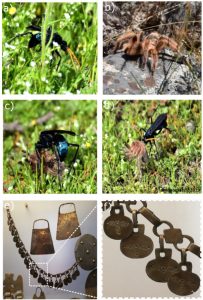
Bird friendly wine country through diversified vineyards
Vinecology, the integration of ecological and viticultural practices, focuses on the working landscapes of the mediterranean‐climate biomes to make wine grape production compatible with species conservation. We examined how maintaining remnant native vegetation and surrounding natural areas in and around vineyards, two primary practices of vinecology, may influence bird community richness and composition across a vineyard landscape. We conducted bird surveys over multiple seasons at 120 sites across a prominent wine‐grape growing region of central Chile. The sites were equally divided across vineyards with and without remnant native vegetation and with varying amounts of adjacent natural habitat. We used generalized linear mixed models (GLMMs) to examine individual species responses to remnant vegetation in the vineyard at plot scale (50 m radius) given the extent of surrounding natural area at the landscape scale (500‐1000 m annular). We used Horn similarity index to explore overall community differences to quantify variations in endemic species, guild detection levels, and species richness between site types. At the plot scale 9 out of 30 species analyzed were positively associated with proportion of remnant vegetation and 3 species were negatively associated. Six were positively influenced by the proportion of native vegetation in the surrounding landscape and 3 species were negatively associated with this landscape scale variable. We found that while overall total detections and richness were significantly greater in continuous mixed forest matorral, 84.9% of the species found there were also detected in forest remnants within vineyards. Endemics, insectivores, granivores, and omnivores were all more abundant in vineyards with remnant native vegetation than in vineyards without remnant native vegetation. Our results show the value of maintaining and restoring natural vegetation remnants in vineyards as a tool for bird conservation that can be applied in working landscapes of the New World Mediterranean (NWM) climate regions.
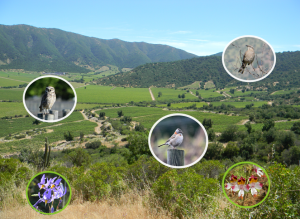
Publication: Bird friendly wine country through diversified vineyards
Agricultural adapters from the vineyard landscape impact native oak woodland birds
Agricultural expansion changes wildlife communities. Some species adapt to working lands, increasing their relative abundance in these modified landscapes, and this may result in spillover effects for communities in adjacent wildlands. These effects remain largely undocumented, even though they can affect biodiversity conservation. We conducted bird surveys at 130 Mediterranean-climate oak woodland locations that exist across a gradient of nearby vineyard development. We used zero inflated Poisson (ZIP) N-mixture models to analyze the relationships among detected bird species, local vegetation, and surrounding vineyard land cover. We used joint species distribution modeling (JSDM) to measure species co-occurrence patterns and account for the influence of the surrounding agricultural land in order to explore indirect effects between bird communities associated with vineyard expansion and oak woodland remnants. We identified 10 species as agricultural adapters based on their positive associated with vineyard land cover. Co-occurrence patterns suggested that i) agricultural adapter species may negatively interact with certain species associated with oak woodlands in adjacent wildlands, so competition with agricultural adapters may be an important driver of biotic homogenization of the community, and (ii) some positive species interactions were detected, especially among insectivore foliage gleaners, which may be facilitated by niche partitioning. Continued examination of spillover effects from agricultural land into adjacent natural areas is warranted in light of global species declines and biotic homogenization.
Publication: Agricultural adapters from the vineyard landscape impact native oakwoodland birds
Evidence synthesis as the basis for decision analysis: a method of selecting the best agricultural practices for multiple ecosystem services
Agricultural management practices have impacts not only on crops and livestock, but also on soil, water, wildlife, and ecosystem services. Agricultural research provides evidence about these impacts, but it is unclear how this evidence should be used to make decisions. Two methods are widely used in decision making: evidence synthesis and decision analysis. However, a system of evidence-based decision making that integrates these two methods has not yet been established. Moreover, the standard methods of evidence synthesis have a narrow focus (e.g., the effects of one management practice), but the standard methods of decision analysis have a wide focus (e.g., the comparative effectiveness of multiple management practices). Thus, there is a mismatch between the outputs from evidence synthesis and the inputs that are needed for decision analysis. We show how evidence for a wide range of agricultural practices can be reviewed and summarized simultaneously (“subject-wide evidence synthesis”), and how this evidence can be assessed by experts and used for decision making (“multiple-criteria decision analysis”). We show how these methods could be used by The Nature Conservancy (TNC) in California to select the best management practices for multiple ecosystem services in Mediterranean-type farmland and rangeland, based on a subject-wide evidence synthesis that was published by Conservation Evidence (www.conservationevidence.com). This method of “evidence-based decision analysis” could be used at different scales, from the local scale (farmers deciding which practices to adopt) to the national or international scale (policy makers deciding which practices to support through agricultural subsidies or other payments for ecosystem services). We discuss the strengths and weaknesses of this method, and we suggest some general principles for improving evidence synthesis as the basis for multi-criteria decision analysis.
Publication: Evidence Synthesis as the Basis for Decision Analysis
Native agrobiodiversity linked to indigenous peoples and peasants in Chile
One of the greatest natural resources that Chile has is its botanical biodiversity. This wealth of plants also extends to those destined for consumption as food by the population, where they have been selecting species and varieties with agricultural interest for centuries, first by indigenous peoples, and now by rural peasant and indigenous communities. Our botanical heritage includes three food species of particular world interest, which are produced in different regions and are part of the diet of multiple cultures: the strawberry (Fragaria chiloensis), the potato (Solanum tuberosum) and the quinoa (Chenopodium quinoa). This book chapter presents a review of the literature on these three species, integrating local and traditional agroecological knowledge about them, and the role of rural communities in safeguarding their genetic heritage.
Publication (in spanish): Capitulo 3 Huertas familiares y comunitarias
Agroecosystems provide habitat for wildlife in a mediterranean-type ecosystem
Understanding the role of agroecosystems as habitat for wildlife is crucial for long-term conservation planning, as different crop stratification, landscape elements, and seasonality influence bird communities. Agriculture is one of the main drivers of land use change, yet these seminatural landscapes can provide habitat for some species, influencing species relative abundance and consequently community composition. The Chilean mediterranean-type ecosystem is highly fragmented by agriculture, the consequences of which for wildlife are poorly understood. Our research aimed to determine how agricultural landscapes varying in land cover characteristics affect bird richness and abundance. We used bird species abundance to evaluate the effects of different agricultural land covers on bird species and communities. We found that abundance of some bird species in agroecosystems in central Chile was higher in winter than in spring, indicating temporal variability in the importance of agroecosystems as bird habitat. We also found that overall bird richness was favored by structural diversity including non-crop structures such as hedgerows, which could be used to manage for bird conservation in temperate agroecosystems. Our results suggest that native vegetation proximity and area may affect seasonal changes in bird communities at larger scales, and that these relationships warrant further study to better understand the role of landscape heterogeneity in these agroecosystems.
Publication https://link.springer.com/article/10.1186/s40693-017-0067-0
[tribulant_slideshow gallery_id=”2″]
Discovery of extended endemic plant distribution reinforces value of priority sites for conservation
The mediterranean-type ecosystems of central Chile are world renowned for their level of species endemism. One of these endemic plant species is Miersia chilensis var. bicolor M. Muñoz, a small cryptic small monocotyledon plant mainly reported in a small area. We found a second population of Miersia chilensis var. bicolor Lonquén hill, a finding that extended the species’ previously understood distribution by 15 kilometers to the north and its altitudinal range by 200 meters. We estimated population size in 2011 and 2015 and reported a significant decline, which may be due to environmental or biotic factors. The new, expanded distribution we reported reinforces the unique value of Lonquén Hill, a priority site for conservation in central Chile.
Publication https://www.biodiversnathist.com/index.php/bnh/article/view/18/23
[tribulant_slideshow gallery_id=”3″]
